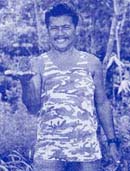 He was once their hunter, now he's their friend... and protector.
He was once their hunter, now he's their friend... and protector.
"Yun ang kinalakihan ko (That was how I was raised)," he says.
So he soon learned his father's craft and assisted him whenever he dad to look for tarsiers and other animals like eagles and parrots in the wild.
Pretty soon, he grew up and his reputation of being a good hunter spread. When he was a young man, foreigners approached him and paid him big money to bring the animals to them.
Sometimes, he'd feel a little guilt about what he was doing. But he often brushed it aside because it was such an easy way to make money in their remote town. Little did he know that years later, he would take on the role of discouraging hunters from exploiting Bohol's wildlife.
Charcoal eaters
The little seeds of kindness were actually wiggling in Mang Lito as early as when he was 12 years old. He always wanted to breed a tarsier in captivity. But he doubted the saying that tarsiers were charcoal eaters."So, nagobserba ako," he says. After the slash and burn farmers would burn part of the forest, he would hide behind trees or in tall grasses to wait for the tarsiers to come. "Naglagay nga ako ng damo-damo sa katawan ko para hindi nila ako makita (I evern wore clumps of grass to disguise myself)," he says.
What he found out changed the way people knew tarsiers.
He noticed that after the burning, new grass would shoot up from the ground. And this is what crickets and grasshoppers liked to eat. That's when the tarsiers would drop from low branches to devour their food. But since it was a kaingin (slash and burn) area, the ground would be scattered with ash and charcoal.
"Yun ang napupunta sa bunganga at pisngi ng mga tarsiers (The tarsiers' faces and hands get smudged with ash and charcoal)," he explains. And that's how tarsiers got this reputation of being charcoal eaters.
 This knowledge enabled Mang Lito to breed a tarsier in captivity and stopped other people (who didn't know any better) from trying to feed tarsiers charcoal.
This knowledge enabled Mang Lito to breed a tarsier in captivity and stopped other people (who didn't know any better) from trying to feed tarsiers charcoal.Mang Lito found himself helping out more and more environmental groups do research on the tarsier until more of his work involved caring for the species. Finally, in 1991, he was asked to be the keeper of the Tarsier Sanctuary of the Philippine Tarsier Foundation in Corella where he now regularly patrols around 180 hectares of forest to track hunters, poachers, loggers and other threats to the tarsier.
He's quite happy with his job now and says it definitely feels right. "Gusto ko kasing makabawi sa ginawa ko," he says ruefully. But once he gets into his job of telling visitors about the tarsier, he gets as animated as a kid, smiling a lot and showing off his favorite tarsiers. He also shushes visitors when they get noisy. "You don't want to stress the tarsiers, do you?" he gently scolds schoolchildren.
Aren't you glad his 12-year-old son self won in the end?